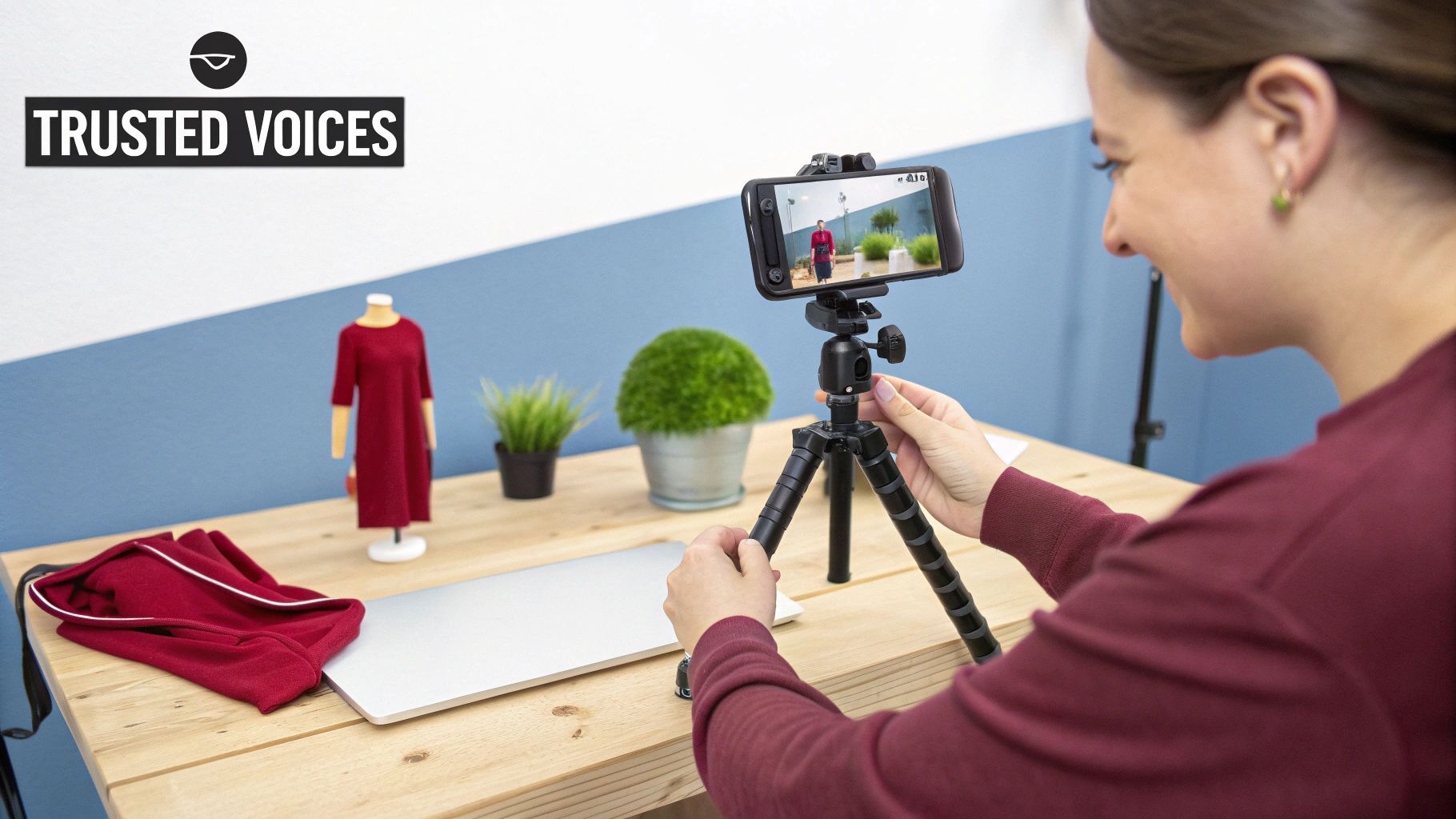A successful product launch doesn’t happen by accident. It's the result of a product launch strategy that fits your product, audience, and budget. Getting this right from the start separates brands that make a splash from those that sink without a trace on competitive marketplaces like Amazon. Instead of a single, one-size-fits-all approach, top sellers pick a model that gives them the best possible start for generating sales and reviews.
This guide breaks down ten distinct launch blueprints, explaining how they work, who they're for, and the practical steps to implement them for your e-commerce brand. This is a playbook of what's working now, designed to give you a clear advantage from day one. To help choose your blueprint, consider the top SaaS marketing strategies for 2025 growth, which can provide a solid foundation for any product launch, particularly for digital or service-based products. Each strategy detailed below offers a unique path to gaining visibility, building social proof, and driving the early momentum needed for long-term success.
1. The Soft Launch: Test Before You Invest
A soft launch is a key part of a modern product launch strategy where you release your new product to a limited, controlled audience before its official, full-scale debut. This approach acts as a real-world stress test, letting you gather customer feedback, find bugs or product flaws, and fine-tune your marketing message without the risk and expense of a huge public rollout. Think of it as a final dress rehearsal to ensure everything is perfect for opening night.

This method helps you validate product-market fit with actual paying customers, not just survey respondents. For example, a brand selling a new kitchen gadget on Amazon might initially launch to a small segment of their email list or a targeted group of shoppers in a specific city. The data from these first sales provides insights into pricing, perceived value, and customer usage patterns. Understanding these early interactions helps you position the product effectively throughout the various stages of the product life cycle.
How to Implement a Soft Launch
- Define Success Metrics: Before you start, decide what a "successful" test looks like. Is it a certain number of sales, a specific conversion rate, or a target customer satisfaction score?
- Select Your Test Audience: Choose a group that represents your ideal customer. This could be a segment of your email subscribers, members of a private social media group, or a geographically targeted audience for your initial ads.
- Establish Feedback Channels: Make it easy for early users to share their thoughts. Set up dedicated email addresses, surveys, or even a private forum where they can report issues and offer suggestions.
2. Influencer & Ambassador Launch
An influencer and ambassador launch uses the credibility of established figures to introduce your product to a built-in, trusting audience. This approach bypasses traditional advertising's skepticism by having respected voices, from industry experts to popular creators, share their authentic experiences with your product. It’s a powerful way to generate immediate social proof, drive awareness, and build brand legitimacy from day one.

This method turns a product announcement into a conversation led by trusted community leaders. For example, GoPro built its brand by sponsoring athletes who used its cameras to capture extreme sports, turning them into powerful ambassadors. Similarly, beauty brand Glossier gave early product access to a small group of influential beauty bloggers, whose authentic reviews created huge demand before the products were even widely available. This product launch strategy is effective because it builds a narrative around your brand through genuine human connection, not just a sales pitch.
How to Implement an Influencer & Ambassador Launch
- Select Value-Aligned Partners: Don't just chase follower counts. Partner with influencers whose audience and personal brand values genuinely match your product. Authenticity is everything.
- Prioritize Micro-Influencers: These creators often have smaller but highly engaged, niche communities. Their recommendations can feel more like a trusted friend's advice and often yield a higher return on investment.
- Track Performance with Unique Codes: Give each influencer unique discount codes or affiliate links. This makes it easy to measure the direct sales and conversions driven by each partnership.
- Build Long-Term Relationships: Instead of one-off sponsored posts, focus on creating a long-term ambassador program. This fosters deeper loyalty and more genuine advocacy for your brand over time.
3. PR & Media Blitz
A PR & media blitz is a concentrated campaign designed to get extensive press coverage and news mentions in a short timeframe. This product launch strategy focuses on compelling storytelling to secure editorial features, creating widespread awareness and instant credibility. Instead of relying only on paid ads, it builds legitimacy through third-party validation from trusted media outlets, making your launch feel like a significant industry event.

This approach is highly effective for innovative or disruptive products where a strong narrative can capture the public’s imagination. For example, the media attention surrounding the initial Oculus Rift launch helped establish VR as the next major tech frontier. Similarly, Tesla's product announcements become global news events due to Elon Musk's mastery of media narratives. By positioning your product as newsworthy, you tap into a powerful engine for organic reach and build a strong foundation for your overall brand awareness strategy.
How to Implement a PR & Media Blitz
- Develop a Compelling Story Angle: Don't just announce a product; tell a story. Frame your launch around a problem it solves, an innovation it introduces, or a trend it represents.
- Build Media Relationships Early: Identify and connect with key journalists and influencers in your niche months before the launch. Provide value and build rapport so your pitch doesn't arrive cold.
- Create a Professional Media Kit: Prepare high-quality assets, including professional product photos, video content, a press release, and founder bios. Make it easy for journalists to cover your story.
- Offer Exclusives: Give a key media outlet an exclusive first look or interview. This can create a ripple effect as other publications rush to cover the story once the embargo lifts.
4. Freemium & Trial Launch
The freemium or trial launch is a product launch strategy centered on rapid user acquisition. It involves offering a free, limited version of your product to attract a large user base quickly. Monetization comes later, by converting these free users into paying customers through premium features, usage-based upgrades, or the removal of limitations. This approach is ideal for digital products, software, or services where the marginal cost of a new user is low.

This model works by demonstrating value upfront, creating a low-risk entry point for potential customers. For instance, Dropbox offers a free storage tier, getting users hooked on the convenience before prompting them to upgrade when they hit their limit. Similarly, Slack allows small teams to collaborate for free, encouraging adoption until a team grows large enough to need paid features. The key is to make the free version valuable enough to attract users but limited enough to create clear incentives for upgrading. This approach can also be a significant driver for improving ecommerce conversion rates by building trust before asking for a sale.
How to Implement a Freemium or Trial Launch
- Define Clear Upgrade Triggers: Make the path from free to paid logical. This could be based on storage limits, the number of users, access to advanced analytics, or removing ads.
- Optimize the Onboarding Process: Your first impression is critical. The initial user experience must quickly and clearly show the core value of your product, making users want to integrate it into their daily workflow.
- Monitor Free-to-Paid Conversion Metrics: Closely track how many free users are converting to paying customers. Analyze this data to understand what features or limitations are most effective at driving upgrades.
- Nurture Free Users: Use email marketing and in-app messaging to educate free users about the benefits of premium features. Offer special discounts or extended trials to encourage them to make the switch.
5. Exclusive/VIP Access Launch
The exclusive or VIP access launch is a product launch strategy that builds anticipation by initially offering a new product only to a select group of people. This approach makes your first customers feel like insiders, turning them into passionate brand advocates. By creating a sense of scarcity and desire, you can generate significant buzz and organic marketing before the product is even available to the general public.
This method works well for brands that have an existing audience or want to position their product as premium or highly sought-after. For example, the audio app Clubhouse famously used an invite-only model to create an air of exclusivity, leading to massive demand. Similarly, Tesla's pre-order system for new vehicles allows early adopters to secure their spot, making each new release a major media event. It’s a powerful way to control initial demand while rewarding your most loyal followers.
How to Implement an Exclusive/VIP Access Launch
- Define Your VIP Criteria: Clearly decide who gets early access. This could be based on past purchase history, engagement on social media, or members of a specific community or email list.
- Build a Waitlist: Create a dedicated landing page for people to sign up for launch updates and a chance to get early access. Showing the number of people on the waitlist can amplify the social proof and urgency.
- Offer Meaningful Perks: Reward your VIPs with more than just early access. Consider offering a lifetime discount, a free bonus gift, or exclusive content to make them feel truly valued for their early support.
6. Event-Driven Launch
An event-driven launch centers your entire product debut around a single, high-impact event, either virtual, in-person, or hybrid. Popularized by tech giants like Apple and Samsung, this approach turns your launch into a must-see spectacle. The event becomes the focal point for generating media buzz, engaging directly with customers, and telling a powerful brand story. It’s designed to create a moment of intense, concentrated excitement that propels the product into the market with massive momentum.
This strategy transforms a simple product release into a memorable brand experience. For instance, Tesla doesn't just announce a new car; it hosts a major unveiling event with product demos and a visionary narrative from its CEO. This method is exceptionally effective for creating a sense of urgency and exclusivity, making audiences feel like they are part of a significant moment. The goal is to dominate the conversation in your industry for a day, driving a flood of traffic, pre-orders, and social media mentions.
How to Implement an Event-Driven Launch
- Build Anticipation: Start weeks in advance with a teaser campaign. Use social media countdowns, cryptic posts, and email hints to create suspense and curiosity around your "big reveal."
- Create a Spectacle: Plan for visually compelling moments that are shareable on social media. This could be a dramatic product unveiling, an impressive live demonstration, or an interactive experience for attendees.
- Make it Accessible: Live stream the event across platforms like YouTube, LinkedIn, and Instagram to reach a global audience. This ensures that customers who cannot attend in person can still participate in the excitement.
- Arm the Press: Prepare a digital press kit with high-resolution photos, video clips, press releases, and key talking points. Make it easy for journalists to cover your launch accurately and enthusiastically.
7. Partnerships & Co-Marketing Launch
A partnerships and co-marketing approach involves collaborating with complementary brands, platforms, or influencers to extend your product’s reach far beyond your own audience. This strategy uses the credibility and customer base of an established partner, creating a powerful endorsement that builds trust and accelerates market penetration. Instead of building momentum from scratch, you tap into an existing network, making this an efficient product launch strategy.
This method is about mutual benefit. For example, a new fitness tracker brand might partner with a popular health food company. The tracker is promoted to the food company's health-conscious customers, while the food brand gets associated with a new wellness technology. Similarly, Uber Eats' partnerships with countless restaurants give them a massive, ready-made inventory, while restaurants gain access to a huge delivery and marketing platform, driving sales they wouldn't have captured otherwise.
How to Implement a Partnerships & Co-Marketing Launch
- Select Strategic Partners: Identify brands that share your target audience and brand values but are not direct competitors. Your ideal partner's products should complement your own.
- Establish Clear Goals and KPIs: Before launching, agree on what success looks like. Define clear expectations for both parties, including lead generation targets, sales goals, or engagement metrics.
- Develop a Joint Marketing Playbook: Create a unified plan detailing the campaign's messaging, promotional channels, timeline, and responsibilities. This ensures both teams are aligned and the execution is seamless.
- Cross-Promote Through All Channels: Maximize visibility by promoting the partnership across all available channels, including email lists, social media accounts, blog content, and paid ad campaigns from both brands.
8. Content Marketing & Educational Launch
This product launch strategy focuses on building trust and authority by educating your target audience before asking for a sale. Instead of leading with a direct sales pitch, you create valuable content like blog posts, tutorials, and webinars that address your customer's pain points and show how your product is the solution. This positions your brand as a helpful expert, making customers more receptive to your product when it officially launches.
By establishing your brand as a thought leader, you attract a warm, engaged audience that already understands the value you provide. For instance, a company selling a new productivity app might create a series of articles on effective time management techniques or host a webinar on overcoming procrastination. This approach nurtures potential customers through their buyer journey, building a relationship long before the "buy now" button appears. This is a core component of a well-rounded approach to e-commerce content marketing.
How to Implement a Content & Educational Launch
- Create a Content Calendar: Plan your content 3-6 months before launch. Align topics with the different stages of the buyer journey, from awareness (what is the problem?) to consideration (what are the solutions?).
- Focus on High-Intent Keywords: Research and target keywords that potential customers use when looking for solutions your product provides. Optimize all content for search to attract organic traffic.
- Build an Email List: Offer valuable, gated content like ebooks or checklists in exchange for an email address. This list becomes your most valuable asset for communicating directly with interested leads during the launch.
- Repurpose Your Best Content: Turn a successful blog post into a video tutorial, a series of social media posts, or an infographic. This maximizes your reach and caters to different content consumption preferences.
9. The Community-First & User-Generated Content Launch
This grassroots product launch strategy focuses on building a dedicated community around your brand before you even launch. Instead of broadcasting a message to a cold audience, you cultivate a loyal following of advocates who feel a sense of ownership in your product's success. These community members become your first customers, your most authentic marketers, and your most valuable source of feedback. It's about creating a movement, not just selling a product.
For example, a company launching a new productivity app might create a Discord server months in advance, inviting early enthusiasts to discuss features and share how they manage their workflows. This not only builds hype but also allows the company to integrate user feedback directly into the development process. By the time the app launches, it already has a built-in user base ready to purchase, promote, and create content for it.
How to Implement a Community-First Launch
- Create a Dedicated Space: Establish a home for your community, whether it’s a private Facebook Group, a Discord server, or a subreddit. This gives members a central place to connect with you and each other.
- Encourage and Reward UGC: Actively feature user-generated content (UGC) like reviews, photos, or tutorials on your social media and product pages. Run contests or create an ambassador program to incentivize high-quality submissions.
- Involve Members in Decisions: Make your community feel valued by asking for their input on product features, packaging designs, or marketing campaigns. Host regular Q&As with founders to foster transparency and build trust.
10. Performance Marketing & Data-Driven Launch
A performance marketing approach is a quantitative and metrics-focused product launch strategy that relies on paid advertising channels to drive immediate results. Instead of waiting for organic growth, this method uses platforms like Amazon PPC, Google Ads, and social media advertising to generate traffic and sales from day one. The core principle is continuous optimization, where real-time data on clicks, conversions, and costs informs every decision, from budget allocation to ad creative.
This strategy is about spending money to make money, efficiently. For example, a brand launching a new supplement might run targeted Amazon Sponsored Products campaigns alongside Facebook ads driving traffic to their Amazon listing. By closely monitoring metrics like Return on Ad Spend (ROAS) and Customer Acquisition Cost (CAC), they can quickly scale the campaigns that are delivering profitable customers and cut the ones that aren't. This data-first mindset removes guesswork and maximizes the impact of every dollar spent, making it a powerful tool for rapid market penetration.
How to Implement a Data-Driven Launch
- Define Key Performance Indicators (KPIs): Before spending a cent, set clear targets for your launch. Establish your maximum acceptable CAC and your target ROAS to ensure your campaigns remain profitable.
- Start with Broad Channel Testing: Allocate small, controlled test budgets across several promising channels, like Sponsored Products, Sponsored Brands, and even off-Amazon sources like TikTok or Instagram ads, to see which delivers the best initial traction.
- Implement Rigorous Tracking: Use tools like Amazon Attribution and UTM parameters for any external traffic. Careful tracking is essential to understand which ads and channels are driving actual sales versus just clicks.
- Optimize and Scale Relentlessly: Monitor campaign performance daily. Reallocate your budget from underperforming ads to your top performers. Use the data from your best customers to build lookalike audiences and refine your targeting for even better results. If you need support with this, professional Amazon ads management can make a significant difference.
10 Product Launch Strategies Comparison
| Strategy | Implementation complexity | Resource requirements | Expected outcomes | Ideal use cases | Key advantages |
|---|---|---|---|---|---|
| Soft Launch Strategy | Medium — staged rollouts, monitoring | Moderate — target markets, analytics, support | Validated product-market fit, reduced large-scale risk | New products, uncertain markets, iterative improvements | Early feedback, controlled scaling, lower initial spend |
| Influencer & Ambassador Launch Strategy | Low–Medium — partner selection and coordination | Medium — talent fees, content production, tracking | Fast awareness and credibility within target niches | Consumer brands, beauty, lifestyle, niche audiences | Trusted endorsements, authentic UGC, targeted reach |
| PR & Media Blitz Strategy | Medium–High — narrative development and outreach | Medium — PR resources, media assets, possible events | Wide awareness, editorial credibility, potential virality | Major announcements, brand positioning, B2C launches | Broad reach, third-party validation, FOMO creation |
| Freemium & Trial Launch Strategy | Medium — product gating and conversion design | High — infrastructure, support, product development | Rapid user growth, low CAC initially, eventual paid conversions | SaaS, apps, platforms with network effects | Low friction adoption, usage data, viral potential |
| Exclusive/VIP Access Launch Strategy | Low–Medium — waitlists and selective access | Low–Moderate — CRM, communications, perks | High desirability, controlled adoption, premium perception | Luxury products, limited releases, brand-first positioning | Scarcity-driven demand, engaged early adopters, premium pricing |
| Event-Driven Launch Strategy | High — event production and timing | High — venue/production, media, streaming capabilities | Memorable launch moments, concentrated press and social buzz | Flagship product reveals, hardware launches, enterprise events | Emotional engagement, live demos, rich content for PR |
| Partnerships & Co-Marketing Launch Strategy | Medium–High — negotiations and coordination | Medium — joint campaigns, integration efforts | Faster distribution, shared audiences, cost mitigation | Channel expansion, complementary products, bundled offers | Shared reach, enhanced credibility, reduced marketing cost |
| Content Marketing & Educational Launch Strategy | Medium — editorial planning and expertise | Moderate — writers, SEO, production time | Long-term organic traffic, authority, qualified leads | Complex B2B, high-consideration purchases, education-driven sales | Sustainable visibility, thought leadership, sales enablement |
| Community-First & UGC Launch Strategy | Medium — community building and moderation | Moderate — community managers, platforms, incentives | Passionate advocates, authentic content, high retention | Developer tools, creator platforms, niche communities | Authentic advocacy, feedback-driven product iteration, lower paid spend |
| Performance Marketing & Data-Driven Launch Strategy | Medium–High — testing, attribution, optimization | High — ad spend, analytics tools, specialist hires | Measurable CAC/ROAS, rapid scalable customer acquisition | Scalable consumer acquisition, ROI-focused product launches | Highly measurable, fast optimization, predictable scaling |
Executing Your Chosen Strategy
The ten product launch strategies we've covered aren't rigid blueprints; they are flexible frameworks. The most effective approach for your brand won't come from picking just one and following it blindly. Instead, real success is found in combining and adapting these models to fit your unique product, audience, and budget. For instance, a community-first launch can be powerfully combined with an influencer campaign to build initial buzz and sustain it with authentic user-generated content.
Your execution plan is where the strategy comes to life. A perfectly designed plan is useless without a clear roadmap for implementation, monitoring, and adjustment. The launch isn't a single event but the start of a sustained process to build momentum. Every action you take, from the first pre-launch email to the final post-launch ad report, should be intentional and data-informed.
From Plan to Profit
The transition from a strategic document to a live, profitable product launch hinges on a few key actions:
Define Your KPIs Early: Don't wait until after the launch to decide what success looks like. Establish your Key Performance Indicators (KPIs) upfront. Are you focused on sales velocity, organic keyword ranking, review count, or brand awareness? Your goals will dictate your tactics. For example, if your primary goal is to hit a specific Best Seller Rank (BSR), your PPC ad spend and promotional strategy will be more aggressive.
Create a Detailed Timeline: Map out every single task, from content creation and ad campaign setup to inventory management and customer service preparation. Assign clear ownership and deadlines for each item. A detailed timeline removes ambiguity and ensures that critical steps aren't missed in the pre-launch chaos.
Stay Agile and Ready to Pivot: No launch ever goes exactly as planned. You might discover a competitor drops their price, your main keyword has a lower search volume than anticipated, or an influencer post performs far better than expected. A successful product launch strategy requires you to monitor performance in real-time and be ready to reallocate your budget and efforts based on what the data tells you.
A critical part of execution is assessing the financial success of your launch; learn how to measure marketing ROI to understand which activities truly drove profitable growth. This analysis will not only validate your current strategy but also provide invaluable insights for your next product release.
Ultimately, a well-executed launch sets the foundation for your product's long-term viability on a competitive marketplace like Amazon. It’s about creating a powerful initial push that the platform's algorithm recognizes and rewards with visibility, which in turn fuels a cycle of organic sales. By focusing on a clear, adaptable, and data-driven execution, you turn a hopeful product idea into a sustainable, profitable asset for your brand.





